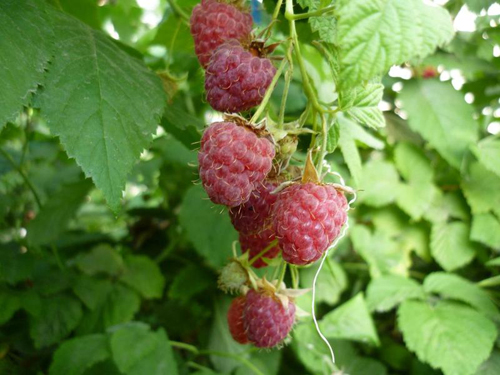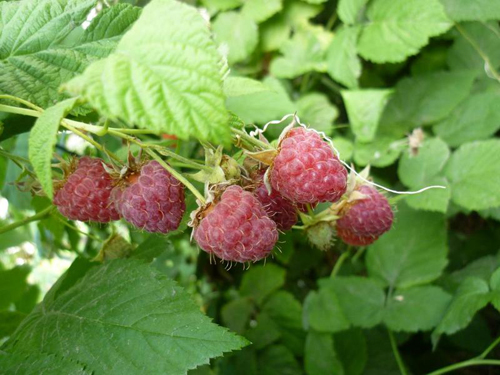Raspberry Variety Balm
Raspberry Balsam is a relatively old, well-known and widespread variety, bred by domestic breeders four decades ago, and has managed to fall in love with both ordinary gardeners and farmers cultivating crops on an industrial scale during this time. Its immediate creator was the famous scientist, Doctor of Agricultural Sciences and Academician of the Russian Academy of Agricultural Sciences, who devoted almost his entire working life to the hybridization of raspberries, Ivan Vasilievich Kazakov.
To breed the variety, the author crossed a variety of American origin called Newburgh with the Bulgarian Ruby in the fields of the Kokinsky stronghold of the All-Russian Institute for Selection and Technology of Horticulture and Nursery (VSTISP), a leading scientific institution specializing in berry crops in our country. A promising form was isolated from the resulting hybrid offspring, which possessed a number of important positive qualities. These included, in particular: increased frost and winter hardiness, good resistance to a number of diseases and pests, rather early and amicable ripening of aesthetically and gastronomically attractive fruits, as well as the versatility of options for using the raspberry crop.

The combination of these, as well as a number of other advantages was confirmed in the course of a long-term state variety testing, which took place over 11 years - from 1982 to 1993. As a result, Balsam was officially entered into the State Register of Breeding Achievements of the Russian Federation, and was recommended for cultivation in a very vast territory, including the North-West, Central, Central Black Earth, North Caucasian, West Siberian and East Siberian regions. Such a wide geography of acclimatization clearly demonstrates the excellent plasticity of the variety and the ability of raspberries to adapt to a variety of growing conditions.
Agrobiological characteristics
Plants have an erect or spreading appearance, showing a growth force above average, and therefore they are able to reach a height of up to 1.8 meters. Long stems need to be tied to the trellis, because otherwise, without support, they lean to the ground under the weight of the crop, and are also damaged due to gusts of strong winds. The shoots are moderately studded, so that the maintenance of the bushes and the harvesting will not be overly difficult. The spikes are short, but with increased rigidity, and are brown. The stems themselves in the first year of life are green, covered with a noticeable layer of wax bloom. In autumn, they ripen, acquiring a light brown hue, which persists in the next season. The intensity of the formation of replacement shoots is good. With the belt method of cultivating bushes, 15-20 young stems grow annually on each running meter of the row. Raspberry leaves are complex, consisting of three or five simple leaves, medium to large in size, located on a moderately long petiole. The leaf blades of the variety are flat, oval-pointed, with a wrinkled, bright green matte surface. The back of the leaves is whitish, you can see slight pubescence on it. In addition, along the main veins there are small, light green, soft spurs with greenish-purple pigmentation. Fruit branches at Balsam are formed in the axils of the leaves, mainly in the upper half of the shoots. They are relatively long, not strongly branching, but up to ten ovaries can form on each of them. The color of the laterals is light green, and in good light it is reddish, due to the accumulation of anthocyanin pigment. Single berries are often formed at the tops of the stems.Root shoots are formed moderately actively, due to which the variety can be attributed to the representatives of that "golden mean", which do not spread too much over the site, but at the same time provide a sufficient amount of planting material for accelerated reproduction.

According to the method of fruiting, our hero belongs to the traditional varieties, in which the harvest appears exclusively on the growth of the second year. Ripening of fruits in him is quite early, occurring in a short time. Already at the end of June, you can feast on the first ripe berries, and at the beginning of July start mass harvesting. Raspberries are easily separated from the fruit, so that picking the fruit will not be too tiring. Sprinkling of berries is not typical for this variety. The total yield is quite good, exceeding 2 kg per bush or 60-80 centners per hectare of plantations. With a high level of agricultural technology, up to 10 tons of raspberries can be harvested from the same unit of area.
The ripe fruits of Balsam are medium, but very leveled in size, broadly conical in shape, 17-18 mm high and 19-20 mm in diameter. Their typical weight is 2.5-3 grams, the color is dark purple or ruby, with a matte surface. Drupes of moderate size, well bonded to each other, do not fall apart under mechanical action of moderate force. The pulp is quite dense, sweet, with a barely noticeable sourness in the aftertaste. Its sugar-acid index is high, consistently exceeding 7 units. The aroma is pronounced, reminiscent of the nature of the fragrance of a wild berry. It manifests itself especially strongly when the bushes are well illuminated by the rays of the sun. The same plants that were grown in the shade do not differ in this magnificence. As a percentage, the content of dry matter in berries is 9-9.5%, the sum of sugars is 7.3%, titratable acids is 1.1%. In addition, biochemical analysis shows the presence of 130 mg of anthocyanins, 25-30 mg of vitamin C, and about 70 mg of vitamin P in 100 g of this raspberry. When eating, bones can be slightly felt, which causes some discomfort, and to some extent reduces the gastronomic dignity of the fruit. ... The average grade received by the variety during tasting is 4.2 points.

There are a lot of options for using the harvested Balsam. It is quite well perceived by consumers when fresh. Due to the dense pulp and resistance to spillage into fragments, the fruits retain their shape and presentation well when moved over long distances. This fact is especially appreciated by farmers who cultivate berries for sale, for many of whom our hero forms the basis of the assortment. The strong aroma is another attractive property for buyers and sellers, allowing the berries to not linger on the shelves. Excellent results are also shown by the processing of raspberries for all kinds of preservation - compotes, preserves, jams, confitures
The cultivation of this variety is within the power of even a novice gardener, due to the comparative unpretentiousness of plants, their ability to grow in a variety of climatic conditions with an unequal level of fertility and the mechanical composition of the soil. Balsam bushes are not only able to withstand severe frosts without much damage, but also well withstand winter drying, in which low temperatures are accompanied by frequent winds. They also have increased resistance to damping, which occurs in other varieties of raspberries with high snow cover. Drought resistance and heat resistance are standard for the culture. Resistance to purple spotting and spider mite damage is increased. Requires routine protection against other diseases and pests.
Agrotechnical measures
The variety is cultivated, like other non-renovated varieties, according to the classic two-year scheme. In the first year, replacement shoots are formed, which, after overwintering, form a harvest in the next season.
Of the important points, it is worth noting the need for a thorough assessment of the planting site from the point of view of the protection of the future raspberry tree from strong winds blowing snow from the site in winter, and thereby lowering the protection of plants in relation to low winter temperatures. You should also not place the culture in lowlands and gullies, where dampness and cold air masses accumulate, which increase the risk of freezing of bushes in the cold season, and fungal infections in summer. The soil for planting Balsam should be well cultivated, it should be free of rhizomes of malicious perennial weeds.
On a growing plantation, raspberries maintain cleanliness in the aisles, if necessary, watering, feeding the plants and the necessary procedures to protect the variety from pathogens, tie the shoots to the trellis, and after harvesting the two-year stems are removed.









The variety is very old - we got it from the previous owner along with the dacha. At first they wanted to cut down all the old raspberries and plant new modern varieties, but after trying the berries, they changed their minds. This raspberry is ideal for me! The berries are the same as for selection, the taste is classic "raspberry", not every variety has such, the aroma is a separate song. When I eat this raspberry, I am transported to the days of my childhood. The variety grows easily - it is a little sick, it is not picky about the soil, but with decent care it pleases with a plentiful harvest, winters well - it never freezes.